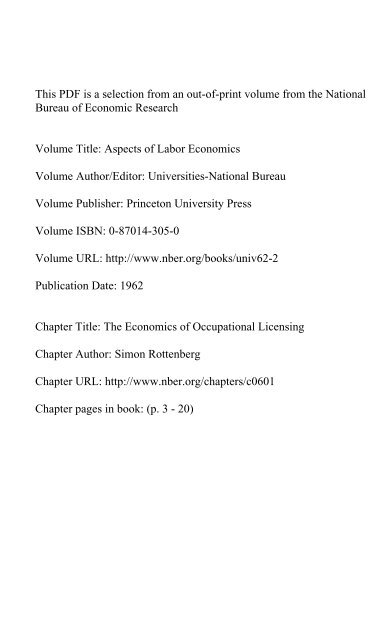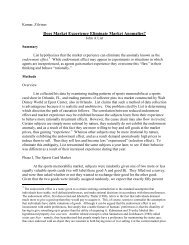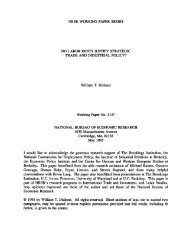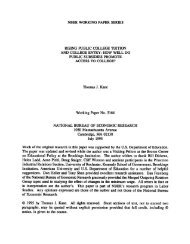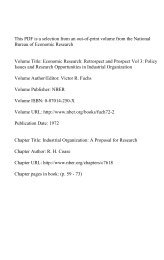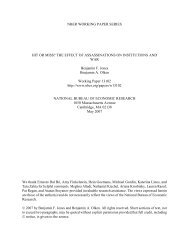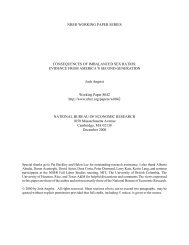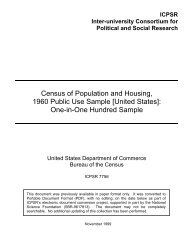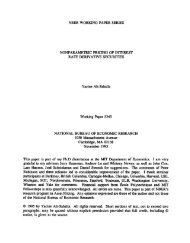The Economics of Occupational Licensing - National Bureau of ...
The Economics of Occupational Licensing - National Bureau of ...
The Economics of Occupational Licensing - National Bureau of ...
Create successful ePaper yourself
Turn your PDF publications into a flip-book with our unique Google optimized e-Paper software.
This PDF is a selection from an out-<strong>of</strong>-print volume from the <strong>National</strong><br />
<strong>Bureau</strong> <strong>of</strong> Economic Research<br />
Volume Title: Aspects <strong>of</strong> Labor <strong>Economics</strong><br />
Volume Author/Editor: Universities-<strong>National</strong> <strong>Bureau</strong><br />
Volume Publisher: Princeton University Press<br />
Volume ISBN: 0-87014-305-0<br />
Volume URL: http://www.nber.org/books/univ62-2<br />
Publication Date: 1962<br />
Chapter Title: <strong>The</strong> <strong>Economics</strong> <strong>of</strong> <strong>Occupational</strong> <strong>Licensing</strong><br />
Chapter Author: Simon Rottenberg<br />
Chapter URL: http://www.nber.org/chapters/c0601<br />
Chapter pages in book: (p. 3 - 20)
<strong>The</strong> <strong>Economics</strong> <strong>of</strong> <strong>Occupational</strong> <strong>Licensing</strong><br />
SIMON ROTTENBERG<br />
UNIVERSITY OF BUFFALO<br />
ENThY into certain vocations has been regulated in this country since<br />
colonial times. During the early national period, many states required<br />
licenses for the practice <strong>of</strong> law and medicine; but the restraints were<br />
eased after about 1820, and by mid-century entry into these pr<strong>of</strong>essions<br />
was open to almost anyone.<br />
<strong>The</strong> present system <strong>of</strong> occupational licensing began in the final<br />
quarter <strong>of</strong> the nineteenth century. Since then, states have licensed more<br />
and more trades; in 1956, Celihorn found some eighty occupations that<br />
needed state licenses to practice, "exclusive <strong>of</strong> owner-business."1<br />
Municipalities as well as states regulate entry, the number <strong>of</strong> licensing<br />
jurisdictions varying among occupations. Some municipalities license<br />
occupations also licensed by their states; some license occupations that<br />
are not state-regulated.<br />
<strong>The</strong> distinction between occupational and business licensing is hard<br />
to draw: to license banks is to license bankers; the license for a liquor<br />
shop also regulates the shopkeeper. In still other ways, occupational<br />
licensing may be indirect rather than direct. In some cases, persons are<br />
not licensed but places, things, or uses are. For example, New York<br />
City licenses billiard and pooi tables, and a person desiring to enter<br />
the pool hail trade requires licenses for his tables. In many places<br />
weapons must be licensed, and such a license requirement might restrict<br />
entry into trades (e.g., bodyguard, watchman) that call for use<br />
<strong>of</strong> weapons. <strong>The</strong> discussion here, however, is limited to vocational<br />
licensing.<br />
To what extent does licensure limit entry into trades? If virtually<br />
all persons can qualify, the requirement that practitioners be licensed<br />
is either a low-cost device for enforcing rules <strong>of</strong> behavior, or a revenue<br />
measure. At the other extreme, the cost <strong>of</strong> the license may be implicitly<br />
infinite, as when licenses are not transferable and there are explicit<br />
limitations <strong>of</strong> numbers, as <strong>of</strong> taxicabs in some cities or <strong>of</strong> taverns per-<br />
Noi'x: <strong>The</strong> preparation <strong>of</strong> this paper was aided by a grant from the Reim<br />
Foundation. <strong>The</strong> paper was written while the author was a member <strong>of</strong> the faculty<br />
<strong>of</strong> the University <strong>of</strong> Chicago.<br />
1 Walter Gellhom, Individual Freedom and Governmental Regtraints, Louisiana<br />
State University Press, 1956, p. 106.<br />
3
ECONOMiCS OF OCCUPATiONAL LiCENSiNG<br />
mitted per police district. Beyond the specified number, no person<br />
may qualify for entry.<br />
Costs <strong>of</strong> entry into a trade may be imposed in other ways than by<br />
licensure. Hygienic standards for restaurants may require investment in<br />
special dishwashing equipment and check entry <strong>of</strong> those for whom the<br />
return would be larger in restaurant keeping than in the next best<br />
alternative, but only if dishwasher capital costs did not have to be incurred.<br />
Similar rules are those requiring licensed funeral directors to<br />
maintain large inventories <strong>of</strong> caskets and laws requiring small coal<br />
mines to enforce federal safety standards. In principle, therefore,<br />
licensure is not different from other rules that increase costs <strong>of</strong> entry<br />
into occupations.<br />
From the earliest times, licensing statutes and ordinances have been<br />
adopted by legislatures on the alleged ground <strong>of</strong> defense <strong>of</strong> the public<br />
health, safety, and morals. In colonial America, "<strong>The</strong> people who carried<br />
on the Indian trade were, as a class, disreputable and not to be trusted.<br />
<strong>The</strong> most natural solution was to allow only responsible and trustworthy<br />
people to engage in this traffic, and, to secure this end, it was enacted<br />
that no one should engage in the Indian trade without a license therefor<br />
from the colonial governor."2<br />
It is true, nevertheless, that (1) when pleas are made to legislatures<br />
for new licensing statutes or for amendments that raise standards<br />
(costs) for qualifying, they are almost invariably made by practitioners<br />
<strong>of</strong> those trades, not by consumers <strong>of</strong> their services; and (2)<br />
standards are established and examinations conducted by boards <strong>of</strong><br />
examiners composed <strong>of</strong> practitioners. <strong>The</strong> vested interest <strong>of</strong> the incumbent<br />
practitioners in restricting numbers in their trade will be<br />
discussed later.<br />
Licenses may be a prerequisite for the practice <strong>of</strong> a trade or they<br />
may only certify as to competence. In the former case only licensed<br />
persons may legally practice the trade; in the latter, anyone may<br />
practice, but only licensed persons may use some specified occupational<br />
title. <strong>The</strong> Illinois Physical <strong>The</strong>rapy Registration Act, for example,<br />
forbids a practitioner to "hold himself out to the public to be a registered<br />
physical therapist unless he is registered by the Department as a physical<br />
therapist," but does not "prevent the practice <strong>of</strong> physical therapy by<br />
2 Thomas K. Urdahi, <strong>The</strong> Fee System in the United States, Madison, Wisconsin,<br />
1898, p. 102.<br />
4
ECONOMICS OF OCCUPATIONAL LiCENSING<br />
a person not registered under the Act." Such a law may limit entry<br />
into a trade if some consumers can be convinced that only registered<br />
practitioners are competent.<br />
<strong>The</strong> enforcement <strong>of</strong> license laws is vested in the diverse authorities<br />
administering the police power <strong>of</strong> government. Often, however, the<br />
real enforcing power lies in the hands <strong>of</strong> trade associations and trade<br />
unions that may maintain inspectors to detect practice by unlicensed<br />
persons. <strong>The</strong>y may enforce the laws by direct action or bring cases<br />
to the attention <strong>of</strong> the public authorities. <strong>The</strong> process <strong>of</strong> detection and<br />
enforcement is costly. Some unlicensed practice will be undetected<br />
or "winked at"; a plumbers trade union might "enforce" the licensing<br />
law in building construction, but not in building maintenance.<br />
While some licenses are required in the construction industry, the<br />
laws fall more heavily on occupations in the tertiary sector <strong>of</strong> the<br />
economy. Within that sector they are concentrated in occupations with<br />
high self-employment and in which services are <strong>of</strong>fered to diverse<br />
buyers and rendered for short periods. Since the license purports to<br />
attest to the quality <strong>of</strong> the licensed person, it supplies information<br />
that, in these occupations, cannot be learned from the experience <strong>of</strong><br />
continuous and long-period employment. Information obtained from<br />
other buyers is presumably more imperfect than that found out more<br />
directly.<br />
Only a small proportion <strong>of</strong> the total labor force is in licensed trades,<br />
despite the continuous increase in the number <strong>of</strong> licensed trades since<br />
the turn <strong>of</strong> the century. Of about 8.8 million persons in the labor force<br />
in Illinois, for instance, it is doubtful that more than 275,000 are in<br />
trades licensed by the Department <strong>of</strong> Registration and Education. <strong>The</strong><br />
numerically important licensed trades, with approximate numbers <strong>of</strong><br />
licensees in that state are:4<br />
Barbers 14,500 Nurses, practical 7,600<br />
Beauty culturists 45,500 Pharmacists 8,600<br />
Embalmers 4,500 Plumbers 5,000<br />
Funeral directors 4,500 Pr<strong>of</strong>essional engineers 15,800<br />
Physicians and surgeons 15,000 Real estate brokers 19,000<br />
Nurses, registered 60,500 Real estate salesmen 14,700<br />
Informal evidence is convincing that the licensure laws are administered<br />
with intent to produce favorable income effects for practitioners.<br />
Complaints against the practice <strong>of</strong> a trade by unlicensed persons and<br />
'Illinois Phyrical <strong>The</strong>rapy Registration Act, Springfield, 1951, pp. 1-2.<br />
4 Report, Illinois Dept. <strong>of</strong> Registration and Education, June 30, 1958.<br />
5
ECONOMICS OF OCCUPATiONAL LICENSING<br />
against the checks on entry imposed by licensing laws come not from<br />
consumers but rather from people in competitive trades; beauty culturists<br />
protest prohibition <strong>of</strong> their cutting hair by barber licensing<br />
laws; drain layers protest limitations imposed upon them by plumber<br />
licensing laws; dental hygienists object to constraints imposed upon<br />
their permissible activities by dental licensing boards; and osteopaths,<br />
chiropodists, chiropractors, and physical therapists complain <strong>of</strong> their<br />
treatment by medical boards. <strong>The</strong> reasons are obvious. Consumers<br />
spend only a small proportion <strong>of</strong> their income on the services <strong>of</strong> people<br />
in licensed trades and a rise in the prices <strong>of</strong> these services affects them<br />
only slightly, while for tradesmen laws limiting the services they may<br />
perform are serious.<br />
In the few cases involving explicit limitation <strong>of</strong> numbers and in<br />
which licenses are transferable (as in some taxicab or liquor dealer<br />
cases), monopoly rents produced by limitation can be capitalized and<br />
transacted. If the condition <strong>of</strong> perfect foresight is fulfilled, the buyer<br />
pays the seller the full value <strong>of</strong> expected rents in the transaction price<br />
and the buyer derives no monopoly income. If licenses are not transferable<br />
or if anyone may acquire a license by meeting stipulated standards,<br />
no rents are earned by those who must incur the costs <strong>of</strong> qualifying.<br />
Persons who have entered a trade at a lower cost, however, do<br />
receive rents, if they can impose higher costs upon new entrants. Thus<br />
incumbents in any trade have the incentive to perpetuate a license<br />
requirement and at ever higher standards. Incumbents in unlicensed<br />
trades may be expected to promote licensing for new entrants, with<br />
entry costs, but only if a "grandfather clause" which licenses incumbents<br />
routinely is included. Without that clause incumbents would<br />
be required to withdraw from the trade and pay the re-entry costs,<br />
thus being deprived <strong>of</strong> their rents. Gelihorn reports that in a single<br />
session <strong>of</strong> the New Jersey legislature practitioners asked that licensure<br />
be required for bait-fishing boats, beauty shops, chain stores, florists,<br />
insurance adjusters, photographers, and master painters, and that<br />
usually grandfather's clauses appeared in the draft proposals. Each<br />
amendment to a licensure law which imposes successively higher entry<br />
costs upon new entrants will create new rents for incumbents.<br />
<strong>The</strong> degrees to which earnings rise and employment declines, because<br />
entry has been made more costly, are functions <strong>of</strong> the elasticities<br />
<strong>of</strong> supply and demand <strong>of</strong> the relevant trade and <strong>of</strong> the magnitude <strong>of</strong><br />
Celihomn, individual Freedonm, p.110.<br />
6
ECONOMICS OF OCCUPATIONAL LICENSING<br />
the increase in entry costs. Since monopoly rents produced by a given<br />
increase in entry costs for new entrants will be the larger, the more<br />
inelastic the demand curve confronting the trade, one would expect<br />
that licensure restricting entry will be more common in trades facing<br />
inelastic than elastic demands. This can be expressed in the following<br />
form: Assume that the cost to incumbents <strong>of</strong> achieving an increase<br />
in entry costs <strong>of</strong> given magnitude is indifferently distributed among<br />
trades and thus equal in all. Assume also that the magnitude <strong>of</strong> an<br />
incremental increase in cost <strong>of</strong> entry is directly proportional to the<br />
costs <strong>of</strong> lobbying, and so forth, incurred by incumbents. On these<br />
assumptions, quasi-rents <strong>of</strong> given magnitude can be acquired by incumbents<br />
the more cheaply, the more inelastic the demand for the<br />
services <strong>of</strong> the trade.<br />
Are there too few people in the licensed trades? Would the economy<br />
gain if more were in these trades and fewer in unlicensed trades? In<br />
other contexts—as where a maximum price is put on the services <strong>of</strong><br />
some class <strong>of</strong> labor which is below the competitive price—insufficiency<br />
<strong>of</strong> resources in the relevant trade is manifested by the failure <strong>of</strong> the<br />
market to clear and the formation <strong>of</strong> queues on the demand side <strong>of</strong><br />
the market. Alternatively, if a floor is placed under prices at higher<br />
than the competitive price, the market will not clear and queues will<br />
form on the supply side. This may be manifested by work sharing<br />
through short workweek schedules and by higher relative hourly wages<br />
than weekly or annual earnings.<br />
If, however, the license restricts entry by imposing higher entry<br />
costs, the market clears and queues do not form, since the numbers<br />
entering will cause the return to effort, adjusted for different quantities<br />
<strong>of</strong> entry-investment in licensed and unlicensed trades, to be the same<br />
for both. <strong>The</strong> price <strong>of</strong> services in the licensed trades will be higher<br />
than they would have been if entry into them were free, and it will<br />
be higher than the price <strong>of</strong> services in comparable unlicensed trades;<br />
but it will be a price that will clear the market.<br />
Thus in Figure 1, if entry is checked only by increasing entry costs,<br />
the supply schedule falls from S to S'; the number employed falls from<br />
OA to OB; and the price rises from OC to OD. <strong>The</strong> market cleared<br />
at X before licensing, and clears at Y after licensing.<br />
If entry is checked only by increasing entry costs, and, in addition,<br />
a floor (E in Figure 1) is put under prices at higher than the new<br />
equilibrium rate, queues will form and work will be nonprice rationed<br />
7
ECONOMiCS OF OCCUPATIONAL LICENSING<br />
among those who have entered, since supply OF will exceed demand<br />
OG, at that price.<br />
If entry is checked not only by increasing entry costs but also by<br />
absolutely - limiting the number who may enter, there will also be<br />
Price<br />
FIGURE 1<br />
0 G B F A Employment<br />
queueing and rationing, but only if the number to which entry is<br />
limited is smaller than the number at which the market will clear;<br />
here entry will be rationed among those who aspire to enter.<br />
Thus in Figure 2, the supply schedule would be SS if entry were<br />
perfectly free and license entry costs were not imposed; S'S', if license<br />
entry costs were imposed; S'XS," if they were imposed and, in addition,<br />
an absolute numerical check is made effective at the number OA.<br />
<strong>The</strong> price OE will prevail and, at that price, OB would enter, if the<br />
numerical check had not been set at OA. AB, therefore, is the number<br />
excluded by the entry-rationing rule. If, <strong>of</strong> course, the numerical limit<br />
were established at OC (or any other number larger than OD), the<br />
8<br />
D<br />
SI<br />
S
ECONOMICS OF OCCUPATiONAL LiCENSiNG<br />
numerical check would be irrelevant, and there would again be neither<br />
queues nor any other form <strong>of</strong> nonprice rationing.<br />
What is the specific nature <strong>of</strong> the checks on entry imposed by<br />
licensing statutes? <strong>The</strong> licensing "industries" produce, to a certain<br />
extent, homogeneous products because unions and associations have<br />
drafted model laws and lobbied for them—with some success. An<br />
FIGURE 2<br />
5,'<br />
SI"<br />
Prtce<br />
/ 0<br />
0 4 D B C Employment<br />
examination <strong>of</strong> the experience <strong>of</strong> a single state, therefore, has something<br />
to tell about the practice <strong>of</strong> all states. In Illinois the following different<br />
kinds <strong>of</strong> checks are imposed by licensing laws: age, general schooling<br />
to specified standards, trade or pr<strong>of</strong>essional schooling, apprenticeship,<br />
and examination. For example, the Funeral Directing and Embalming<br />
Law limits the practice <strong>of</strong> funeral directing to registered funeral<br />
directors. Requirements for registration are that the applicant be at<br />
least twenty years old and a citizen <strong>of</strong> Illinois, <strong>of</strong> good moral character<br />
and temperate habits, be certified as a registered embalmer and have<br />
9
ECONOMiCS OF OCCUPATiONAL LiCENSING<br />
passed an examination. For the prior qualifying test for registration as<br />
an embalmer, requirements are to be at least twenty-one years old and<br />
<strong>of</strong> good character, to have completed one academic year in an approved<br />
college or university, to be a graduate <strong>of</strong> an approved school<br />
<strong>of</strong> embalming (at least nine months' course), to have been apprenticed<br />
to a registered embalmer in Illinois for at least one year, to have passed<br />
an examination and be "properly protected against communicable<br />
dliseases."6<br />
This is not an uncommon set <strong>of</strong> qualifying rules. Each rule separately<br />
will check entry to a trade, either by imposing explicit costs or implicit<br />
costs. For instance, requirement <strong>of</strong> general or pr<strong>of</strong>essional schooling at<br />
specified standards imposes tuition and foregone income costs during<br />
the period <strong>of</strong> schooling. <strong>The</strong>se higher entry costs in the licensed trade<br />
cause the supply curve <strong>of</strong> labor to fall and the price <strong>of</strong> services <strong>of</strong> labor<br />
in the trade to rise. <strong>The</strong> return to effort in a licensed trade, adjusted for<br />
the relative costs <strong>of</strong> entry, will be the same as in unlicensed trades, but<br />
only if, at each possible price <strong>of</strong> labor, new entrants are fewer than<br />
would have been attracted to it in the absence <strong>of</strong> higher entry costs.<br />
On the principle that people distribute themselves among employments<br />
in ways that make net advantage equal in all, the latter outcome can<br />
be expected. If, with higher entry costs, the supply curve did not fall,<br />
the price <strong>of</strong> labor would not be higher and the yield to effort (adjusted<br />
for entry costs) would be lower in licensed than in unlicensed trades.<br />
When the qualifying rules impose entry costs, employment in the<br />
licensed trade is rationed by price.<br />
An example <strong>of</strong> nonprice rationing rules is the previously mentioned<br />
requirement <strong>of</strong> a specified age. <strong>The</strong> result is the same as in the case <strong>of</strong><br />
price-rationing rules, except that the age composition in the trade will<br />
be different from what it would be if entry were free. <strong>The</strong> age requirement<br />
will demand a higher price to attract a given number <strong>of</strong> new<br />
entrants (i.e., the supply schedule will fall), because some entrants to<br />
the licensed trade will have acquired skills with experience in other<br />
employments while "waiting" to meet the age limit. In addition, their<br />
opportunity costs will have risen; they will have better alternatives<br />
than they would have had if they had been permitted to enter the trade<br />
at an earlier age. As before, the adjusted return to effort will be the<br />
same in all trades, licensed and unlicensed. <strong>The</strong> number employed in<br />
the licensed trade will be smaller than if entry into it were free, if<br />
6 Illinois Funeral Directing and Embalming Law, Springfield, 1958.<br />
10
ECONOMICS OF OCCUPATiONAL LICENSING<br />
the demand schedule for labor in the trade is negatively sloping; numbers<br />
employed will be unaffected only if the demand schedule is perfectly<br />
inelastic.<br />
If there is an explicit numerical check on entry (as when the number<br />
<strong>of</strong> licenses is limited), if licenses are not rationed by price, and if<br />
licenses are nontransferable, a different result from those <strong>of</strong> the foregoing<br />
cases ensues. <strong>The</strong> number in the trade will be less, the price<br />
<strong>of</strong> labor <strong>of</strong> the trade will be higher, just as in the other cases, but the<br />
return to effort will be higher than in other trades. Sufficient additional<br />
numbers cannot be transferred to the trade to wipe out the real differential<br />
in it because <strong>of</strong> the constraint on the number <strong>of</strong> entrants permitted.<br />
If, however, the number <strong>of</strong> licensees is equal to or greater than<br />
the number who would have made their way into the trade, if there<br />
were no licensing, none <strong>of</strong> these consequences follow and the licensing<br />
becomes nonrestrictive and irrelevant. If licenses are transferable, even<br />
in the case <strong>of</strong> explicit numerical checks, there will be no difference<br />
between the case <strong>of</strong> numerical checks and the other cases, and the<br />
return to effort (adjusted for entry costs) wifi be the same in all trades.<br />
In trades where licensing checks are imposed on new entrants but.<br />
not on incumbents, the return to effort will be higher for incumbents<br />
than in other trades because <strong>of</strong> their freedom from the additional costs<br />
<strong>of</strong> entry, but it will not be higher for new entrants who do incur these<br />
costs. Since only incumbents earn quasi-rents from checking entry by<br />
imposing new costs <strong>of</strong> entry, it is to be expected that there will be<br />
successive demands for making entry costs higher. Each generation<br />
<strong>of</strong> entrants will seek to make entry more costly for succeeding generations.<br />
That process was noted above: legislatures are not only con-.<br />
tinuously confronted by requests <strong>of</strong> unlicensed trades that they be<br />
licensed but also by requests <strong>of</strong> licensed tradesmen that qualifying<br />
standards for their trades be raised. Usually, legislatures are <strong>of</strong>fered<br />
a package which includes blanket exemption from the new costs <strong>of</strong><br />
those already practicing the trade.<br />
<strong>The</strong> history <strong>of</strong> Illinois barber licensing is a case in point. In 1909,<br />
a law was passed requiring that a person not then practicing barbering<br />
would have to serve an apprenticeship or attend a barber school and<br />
pass an examination to be licensed to practice. A 1927 law specified<br />
that only those who had completed eight grades <strong>of</strong> school could qualify<br />
Sinith-Hurci, Illinois Annotated Statutes, Chap. 18 3/4, "Barbers, Historical<br />
Note."<br />
11
ECONOMICS OF OCCUPATIONAL LICENSING<br />
to become apprentices. A 1929 amendment required both six months'<br />
barber schooling and an apprenticeship for a license. Further rises<br />
in standards followed: 1937, age standards; 1939, entry only to citizens<br />
and aliens who had ified intention to be naturalized; 1947, the course<br />
<strong>of</strong> instruction in barber school lengthened from six to nine months;<br />
1951, completion <strong>of</strong> ten years <strong>of</strong> school for enrollment as a student<br />
barber,<br />
If foresight is perfect, the rejection rate (the ratio <strong>of</strong> failures to numbers<br />
examined) will be zero, If the rejection rate is positive, and if<br />
the qualifying standards are honestly applied and not used as a covert<br />
strategy for hiding explicit numerical entry checks, it is because foresight<br />
is less than perfect.<br />
Less than perfect foresight is a necessary condition for the existence<br />
<strong>of</strong> gains from licensing (through use <strong>of</strong> increased entry costs). Incumbents<br />
free <strong>of</strong> entry costs imposed on new entrants gain by increased<br />
income. <strong>The</strong> gain is equivalent to that accruing to the sellers <strong>of</strong> transferable<br />
licenses after the capital value <strong>of</strong> the licenses has risen. In both<br />
cases, the gain is produced by lack <strong>of</strong> foresight. If the market had been<br />
estimated correctly there would be no rise in transferable license capital<br />
values. If the behavior <strong>of</strong> legislatures had been estimated correctly,<br />
entrants would have crowded into the trade before higher costs <strong>of</strong><br />
entry had been imposed, so that earnings would have been lower in<br />
the prelicensing period and higher in the posflicensing period, but<br />
equal to adjusted earnings in other similar trades over the long run.<br />
In conditions <strong>of</strong> uncertainty, the more shrewd estimate correctly the<br />
probability that higher entry costs will be required <strong>of</strong> new entrants<br />
and take advantage <strong>of</strong> the lower entry costs, while the less shrewd<br />
underestimate the probability. If there is overestimation <strong>of</strong> the probability,<br />
too many crowd into the trade, and returns fall below those<br />
in comparable employments.<br />
<strong>The</strong> larger the cost <strong>of</strong> entry relative to the current value <strong>of</strong> the expected<br />
income from a trade, compared with other trades, the smaller<br />
will be the number who enter; therefore, the magnitude <strong>of</strong> the entry<br />
cost imposed by licensing is an index <strong>of</strong> the power <strong>of</strong> the license to<br />
check entry. <strong>The</strong> larger the relative cost <strong>of</strong> entry and, therefore, the<br />
higher the price <strong>of</strong> labor in the trade, the larger is the incentive to<br />
engage in unlicensed practice. Aspirants will seek to be illegally<br />
licensed—as by buying passing grades on examinations—if the cost<br />
12
ECONOMICS OF OCCUPATIONAL LiCENSiNG<br />
is less than the cost <strong>of</strong> acquiring the information necessary to pass<br />
the examination.<br />
Why do licensing arrangements usually check entry by imposing<br />
entry costs rather than in other ways, say, by explicit numerical checks?<br />
<strong>The</strong> answer is that the costs can be defended on grounds that standards<br />
are being raised and consumers are being protected against the consequences<br />
<strong>of</strong> error. Pleas can be made for the public interest. Explicit<br />
numerical checks must be defended on grounds <strong>of</strong> external diseconomies;<br />
too many taxis, racing for customers, will cause accidents on<br />
the streets, or too many taverns will cheapen liquor and increase<br />
drinking. Legislatures appear to consider adverse third-party effects<br />
less plausible than higher standards as grounds for licensing for most<br />
trades.<br />
Costs <strong>of</strong> entry imposed by licensing are <strong>of</strong> diverse classes. Some who<br />
gain from increased entry costs for others are indifferent to the nature<br />
<strong>of</strong> the costs and interested only in their aggregate magnitude. Others<br />
gain only if costs are increased by requiring that their services be<br />
bought by aspirants in order to qualify for entry. For example, owners<br />
<strong>of</strong> colleges <strong>of</strong> embalming and teachers in them prefer that all prospective<br />
registered embalmers be required to enroll in such colleges, that<br />
the course <strong>of</strong> instruction to be taken be for longer rather than shorter<br />
periods, and that the whole cost <strong>of</strong> entry be spent for embalming<br />
college instruction. Some evidence <strong>of</strong> this attitude is found in attempts<br />
to monopolize the required services by owners <strong>of</strong> barber schools, who<br />
oppose the teaching <strong>of</strong> barbering in public vocational schools and<br />
prisons.<br />
<strong>The</strong> age composition <strong>of</strong> persons in licensed trades can be expected<br />
to be different from that in similar unlicensed trades, and the mean age<br />
in licensed trades is higher. New entrants to the labor market, making<br />
their first occupational choices, choose indifferently between free-entry<br />
occupations with low earnings and positive entry-cost occupations with<br />
high expected earnings, so long as the yield to effort, adjusted for<br />
entry costs, is the same in both. [f the rules for rationing licensed employments<br />
among first-job choosers are indifferent to age, new entrants<br />
into licensed and unlicensed trades will be random with respect to<br />
the age <strong>of</strong> new entrants to the labor market. But where entry into the<br />
licensed trades is postponed by age or educational qualifications for<br />
admission, the age <strong>of</strong> entry <strong>of</strong> first-job takers into licensed trades will<br />
be higher than into similar unlicensed trades.<br />
13
ECONOMICS OF OCCUPATiONAL LiCENSiNG<br />
<strong>The</strong>re will be little movement between the two kinds <strong>of</strong> trades during<br />
the middle years <strong>of</strong> working life. Once having entered a licensed trade,<br />
the licensee will be reluctant to leave. <strong>The</strong> skills and knowledge which<br />
the licensing requirements compelled him to acquire are specialized<br />
to the licensed trade and will yield income to him only in that trade.<br />
Outmigration from licensed trades will be low also among those in a<br />
licensed trade who entered the trade when entry was free or when the<br />
cost <strong>of</strong> entry was lower than that currently prevailing. <strong>The</strong>y will earn<br />
quasi-rents in that trade, but they wifi earn no rents in any other. Inmigration<br />
to licensed trades <strong>of</strong> unlicensed tradesmen in their middle<br />
years will also be low for two reasons. Where the acquisition <strong>of</strong> a<br />
license requires full-time schooling or apprenticeship, income is foregone.<br />
Since earnings <strong>of</strong> persons in their middle years are higher than<br />
for younger men, the cost, in foregone income, <strong>of</strong> training for entry<br />
into the licensed trades will be higher. Furthermore, the period <strong>of</strong><br />
pay<strong>of</strong>f for investment in training will be shorter for older men than<br />
for younger.<br />
<strong>The</strong> mean age <strong>of</strong> retirement from licensed trades will be higher<br />
than from similar unlicensed trades. <strong>The</strong> cost <strong>of</strong> retirement is the loss<br />
<strong>of</strong> earnings that would have been received, if retirement had been<br />
postponed. Since licensing, by checking entry, causes earnings to rise,<br />
this cost will be higher in licensed than in unlicensed similar employments.<br />
Aggregating these components—higher age <strong>of</strong> entry into licensed<br />
trades and <strong>of</strong> exit from them, and small net movements between<br />
licensed and unlicensed trades—produces a higher mean age in licensed<br />
trades.<br />
Postscript on Barber <strong>Licensing</strong> in Illinois<br />
I propose now to examine licensure in the barber industry with special<br />
reference to the State <strong>of</strong> Illinois. Forty-seven <strong>of</strong> the old forty-eight<br />
states license barbers.<br />
Barber examining boards are almost always composed <strong>of</strong> practitioners.<br />
Some years ago Chicago proposed to license barbers municipally<br />
(state licensing has been in effect since 1909). <strong>The</strong> barber trade<br />
unions and associations opposed municipal licensing, unless the city<br />
examining board be composed <strong>of</strong> barbers but, failing the mayor's consent,<br />
the licensing ordinance was not adopted.<br />
It is evident that barbers desire to use licensure to restrict entry.<br />
14
ECONOMICS OF OCCUPATIONAL LICENSING<br />
One <strong>of</strong> the vice presidents <strong>of</strong> the Barber's Union (Journeymen Barbers,<br />
Hair Dressers, and Cosmetologists) wrote in the union journal:8<br />
While the barber boards, barber schools and the International Union<br />
are separate organizations, there is much in common between them.<br />
We are particularly pleased to see the Barber Boards <strong>of</strong> 47 States<br />
giving heed to the law <strong>of</strong> supply and demand. Good schools and<br />
well-trained students are necessary for future progress <strong>of</strong> the barber<br />
pr<strong>of</strong>ession, but too many schools and too many students . . . can<br />
stop progress and shatter the hopes <strong>of</strong> the future. . . . Operators <strong>of</strong><br />
schools and colleges should put teaching and sufficient training ahead<br />
<strong>of</strong> accumulating dollars. . . . This cannot be done if students do not<br />
have sufficient practice on the chair. Too many students mean too<br />
many poorly trained students and too many poorly trained students<br />
mean too many cut-rate barbers. <strong>The</strong> law <strong>of</strong> supply and demand<br />
must be heeded if we are to continue to hold our present price<br />
structure and go forward to make our pr<strong>of</strong>ession what it should be.<br />
<strong>The</strong> union's president enumerated the achievements <strong>of</strong> the union in<br />
its seventy-two year history: "established individual health requirements<br />
for practitioners, shop sanitation standards, pr<strong>of</strong>essional educational<br />
requirements, educational programs calling for practical training,<br />
examinations, apprenticeship terms, 'State license laws. . . ." All<br />
these achievements have the effect <strong>of</strong> limiting numbers in the trade.<br />
<strong>The</strong>re is a network <strong>of</strong> organizations through which the restrictive<br />
strategy is made effective. <strong>The</strong>se include the state barber associations,<br />
which are the legislative arm <strong>of</strong> the union, a <strong>National</strong> Association <strong>of</strong><br />
Barber Examiners, a Barber Schools Association, and associations <strong>of</strong><br />
employing and self-employed barbers.<br />
In Illinois the number <strong>of</strong> barbers has been declining relative to total<br />
and active population. <strong>The</strong> census <strong>of</strong> 1950 counted fewer barbers<br />
(males in the occupational class, "barbers, beauticians, and manicurists")<br />
than did the 1920 census.<br />
illinois<br />
Census Count<br />
Barbers per 1,000: 1950 1920<br />
Total population 1.4 2.0<br />
Active population 8.2 4.9<br />
8 Jourswynian Barber, Nov. 1958, pp. 395, 397.<br />
15
ECONOMICS OF OCCUPATIONAL LiCENSiNG<br />
<strong>The</strong> relatively diminished number <strong>of</strong> barbers is not conclusive pro<strong>of</strong><br />
that licensing has checked entry. It may simply be evidence that barbering<br />
is a declining industry and that others perform the services<br />
formerly done by barbers. It may also be evidence <strong>of</strong> technological<br />
progress, as the invention <strong>of</strong> electric hair clippers, which caused a<br />
given demand schedule for barber services to be transformed into a<br />
fallen demand schedule for barbers.<br />
<strong>The</strong> demand for barber services seems to be somewhat inelastic.<br />
While the invention <strong>of</strong> the safety razor produced a good substitute for<br />
barber shaving services, there does not seem to be a good substitute<br />
for haircutting services. Some degree <strong>of</strong> elasticity is produced by the<br />
possibility <strong>of</strong> diminishing the frequency <strong>of</strong> haircuts as prices rise, and<br />
the do-it-yourself movement can make some progress. Indeed the union<br />
is aware <strong>of</strong> the threat posed by do-it-yourself. <strong>The</strong> president <strong>of</strong> the<br />
union wrote:°<br />
Certain manufacturing interests and supply dealers . . . have aided<br />
and abetted the so-called 'Do-It-Yourself' slogan. <strong>The</strong>y have advertised<br />
and sold to the general public hair cutting sets, cosmetics<br />
and other supplies used in barber and beauty shops. <strong>The</strong> International<br />
Union [is] . . . opposed to the 'Do-It-Yourself' program. We<br />
believe that the manufacturers <strong>of</strong> products used in barber and beauty<br />
shops should sell directly to those shops—not disperse to drug and<br />
department stores for over-the-counter sales. .. . When manufacturers<br />
advertise . . . that the general public can perform these services,<br />
they are in competition with our people.<br />
Some elasticity is probably introduced by employment <strong>of</strong> unlicensed<br />
barbers. It would be difficult for them, however, to operate in street<br />
shops, and most unlicensed barbering is probably confined to itinerants<br />
who cut hair out <strong>of</strong> sight <strong>of</strong> licensing board inspectors.<br />
<strong>The</strong> cost <strong>of</strong> entry into the occupation, in the absence <strong>of</strong> licensing<br />
requirements, would be low. <strong>The</strong> legislative representative <strong>of</strong> the union<br />
estimated in 1958 that the cost <strong>of</strong> equipping a one-chair barber shop<br />
was $1,500.10 Another estimate puts entry costs at $1,000 per chair for<br />
a three-chair shop and less per chair for larger shops where plumbing<br />
and electrical installation overhead can be distributed over a larger<br />
number <strong>of</strong> chairs.'1<br />
Ibid., June 1958, p. 197.<br />
"Interview with proprietor <strong>of</strong> Moler Barber School, Chicago.<br />
16<br />
10 Ibid., April 1958, p. 127.
ECONOMICS OF OCCUPATIONAL LICENSING<br />
<strong>The</strong> Illinois barber licensing law requires annual renewal <strong>of</strong> licenses.<br />
<strong>The</strong> flow <strong>of</strong> new entrants into the trade seems to be insufficient to<br />
compensate for deaths and retirements, so that in Illinois the stock<br />
<strong>of</strong> licensed barbers has declined somewhat, as shown in the next<br />
tabulation.12<br />
New Barber Licenses Sum <strong>of</strong> New and<br />
as Percentage <strong>of</strong> Renewed Barber<br />
Year Renewed Licenses Licenses<br />
1950 4.41 14,822<br />
1953 3.33 14,998<br />
1956 2.80 14,748<br />
1958 2.87 14,484<br />
<strong>The</strong> price <strong>of</strong> barber services in Chicago has risen relatively in recent<br />
years. <strong>The</strong> <strong>Bureau</strong> <strong>of</strong> Labor Statistics sample for measuring price<br />
changes for barber services consists <strong>of</strong> two union shops, one in the<br />
central city and one outlying. Only one item—male haircuts—is priced,<br />
once each quarter. <strong>The</strong> prices since December 1952 have been:<br />
December, 1952 to June, 1955 $1.50<br />
September, 1955 to March, 1959 1.75<br />
June, 1959— 2.00<br />
Since some barber services are sold in Chicago at less than the union<br />
rate, the BLS price is not accurate, but no better index is available.<br />
<strong>The</strong> "all-items" BLS consumer price index for cities rose by 10 per cent<br />
from 1952 to July, 1959.<br />
<strong>The</strong> Illinois barber licensing law is sufficiently comprehensive to<br />
make it appear unlawful for any person to shave himself, if he is not a<br />
licensed barber. <strong>The</strong> law reads, in part (paraphrased) : ' It is unlawful<br />
for any person to practice barbering without a certificate <strong>of</strong> registration<br />
as a registered barber. Anyone <strong>of</strong> the following constitutes the practice<br />
<strong>of</strong> barbering: to shave or trim the beard or cut the hair.<br />
A barber committee (three barbers, each licensed for at least five<br />
years) must consent to the following standards before they can be<br />
applied by the state government: ascertain the fitness <strong>of</strong> applicants for<br />
licenses; prescribe rules for examining applicants; establish standards<br />
for barber schools; establish standards <strong>of</strong> prior education for admission<br />
12 Annual Reports, Illinois Dept. <strong>of</strong> Registration and Education.<br />
1 Illinois Barber Law, Dept. <strong>of</strong> Registration and Education, 1959.<br />
17
ECONOMiCS OF OCCUPATIONAL LICENSING<br />
to barber schools; conduct hearings on license revocations and<br />
suspensions.<br />
<strong>The</strong> law requires student barbers to have certificates <strong>of</strong> registration;<br />
to qualify they must be sixteen and one-half years old, be U.S. citizens,<br />
and must have completed two years <strong>of</strong> high school. Apprentice barbers<br />
must also have certificates <strong>of</strong> registration. Qualifying standards require<br />
seventeen and one-fourth years <strong>of</strong> age; successful completion <strong>of</strong> a course<br />
<strong>of</strong> study in a recognized barber school (1,872 hours completed in not<br />
less than nine months); passing an examination in the primary theory<br />
and practice <strong>of</strong> barber science and art, including anatomy, physiology,<br />
skin diseases, hygiene and sanitation, bacteriology, barber history and<br />
law, pharmacology, electricity and light, haircutting, shaving and<br />
shampooing, massaging, and implements. No barber shop may employ<br />
more than one apprentice for each registered barber it employs. <strong>The</strong><br />
period <strong>of</strong> apprenticeship must be at least two and one-quarter years.<br />
Requirements for the certificate as a registered barber (the barber<br />
license) are: age, nineteen and one-half years; completion <strong>of</strong> the<br />
period <strong>of</strong> apprenticeship; success in a second examination covering<br />
scientific scalp and facial treatments for cosmetic purposes, use <strong>of</strong><br />
creams, lotions, and other preparations in conjunction with galvanic,<br />
faradic, and high frequency electricity, ultra violet radiation, vibratory<br />
appliances, barber shop management, ethics, salesmanship, standardized<br />
services, advanced haircutting and shaving technique (including scientific<br />
finishing and artistic grooming), and pr<strong>of</strong>essional courtesy.<br />
<strong>The</strong> law also defines standards for recognized barber schools with<br />
respect to curriculum, teaching staff, location, etc.; establishes standards<br />
<strong>of</strong> practice for barbers; and provides for the three types <strong>of</strong> licenses<br />
for barber teachers—theory, practice, and joint theory and practice.<br />
It is clear from a mere recital <strong>of</strong> the law that it imposes entry costs<br />
<strong>of</strong> some magnitude, and that consumers searching for a qualified person<br />
merely to cut hair must pay for a tie-in package <strong>of</strong> many other skills<br />
superfluous for this purpose. Presumably, most people seek haircutting<br />
rather than scalp care services in barber shops. A recent issue <strong>of</strong> a<br />
barber's magazine suggests that incumbents do not know "barber<br />
science" well, unless they know whether the discovery <strong>of</strong> bacteria is<br />
credited to Louis Pasteur, whether Vitamin D is effective against scurvy,<br />
whether proteins contain traces <strong>of</strong> phosphorous, and whether arrector<br />
muscles pass from the surface <strong>of</strong> the true skin.'4<br />
'4Mastcr Barber and Beautician Magazine, January 1958.<br />
18
ECONOMICS OF OCCUPATiONAL LICENSING<br />
<strong>The</strong> barber case exhibits a common characteristic <strong>of</strong> occupational<br />
licensing: by requiring longer periods <strong>of</strong> schooling than is objectively<br />
required for the learning <strong>of</strong> skills and knowledge relevant to the praclice<br />
<strong>of</strong> the craft, things relevant to other crafts are also learned. <strong>The</strong><br />
system defines high minimum standards for practitioners. It raises<br />
(albeit unnecessarily) the mean quality <strong>of</strong> legal practitioners (when<br />
quality is measured by the sum <strong>of</strong> knowledge commanded) and<br />
diminishes the dispersion about the mean. Put otherwise, it diminishes<br />
specialization in skill acquisition and (somewhat less certainly) specialization<br />
in the exercise <strong>of</strong> skili, by insisting that all practitioners be qualified<br />
in many disciplines.<br />
It should be noted parenthetically that, while licensing causes the<br />
mean quality <strong>of</strong> legal practitioners to rise, by excluding those at the<br />
lower part <strong>of</strong> the qualitative range who could have practiced legally<br />
in the absence <strong>of</strong> a licensing statute, it does not necessarily cause the<br />
mean quality <strong>of</strong> the relevant service to rise. Whether it does or not<br />
turns on the behavior <strong>of</strong> consumers <strong>of</strong> the service after the trade has<br />
been licensed, who in the absence <strong>of</strong> licensing would have employed<br />
the qualitatively low tradesmen who sold their services at correspondingly<br />
low prices. If consumers substitute for low-quality barbers, who<br />
are now not permitted to practice, the haircutting services <strong>of</strong> their<br />
wives, the qualitative mean falls; if they substitute the services <strong>of</strong><br />
higher-quality barbers, the qualitative mean rises. If both occur, as is<br />
likely, the outcome is an arithmetic consequence <strong>of</strong> the magnitudes <strong>of</strong><br />
opposite movements.<br />
Barber licensing laws are more restrictive in some states than in<br />
others. Both the Barbers' Union and the Master Barbers' Association<br />
oppose reciprocity <strong>of</strong> licensing among the states.15 This is a rational<br />
policy for them, for, if reciprocity prevailed, people would enter<br />
through the widest door, and high entry costs in some states would be<br />
vitiated by low costs in others.<br />
In addition to restricting entry into the trade, barbers also fix prices<br />
for their services either directly or by lobbying for state minimum-price<br />
laws for barber services. Fourteen states have such laws. It is reasonable<br />
to surmise that the fixed price is higher than a price determined by<br />
the demand and the (restricted) supply schedules. If the higher price<br />
is secured by price fixing rather than by imposing still higher entry<br />
costs, it may be either because the cost <strong>of</strong> pursuing price-fixing strategy<br />
Journeyman Barber, October 1957, P. 298; and June 1958, p. 197.<br />
19
ECONOMiCS OF OCCUPATIONAL LICENSiNG<br />
is lower than the cost <strong>of</strong> the latter, or because practitioners are mipatient<br />
to have higher prices and seek to avoid the long run during<br />
which higher entry costs check new entrants.<br />
<strong>The</strong> additional numbers who may be attracted to the barbering trade<br />
by the higher prices may be prevented from entering by the imposition<br />
<strong>of</strong> additional entry costs. Alternatively, when prices for barber services<br />
are fixed at levels above what would be determined by the intersection<br />
<strong>of</strong> the demand and supply schedules, there will be an excess <strong>of</strong> supply.<br />
Demand will then be rationed among incumbents in the industry.<br />
Hypothetically, the rationing could occur by having employing barbers<br />
choose among licensed barbers. But any barber unemployed as a result<br />
<strong>of</strong> this rationing process would be able to establish his own firm (i.e.,<br />
to employ himself in an own-account business), since there are no<br />
legal restraints on establishing new barber shops, and the cost to already<br />
licensed barbers <strong>of</strong> entry into the industry is low. <strong>The</strong>refore, the excess<br />
supply would cause demand to be rationed by the choices <strong>of</strong> consumers<br />
among barbers who present themselves for employment. <strong>The</strong> result<br />
would be an average less-than-full workweek in the barbering trade.<br />
<strong>The</strong> specification and enforcement <strong>of</strong> a minimum price does not<br />
mean that barber services will be uniformly priced in all establishments.<br />
In some, prices higher than the minimum will be charged, and the<br />
products <strong>of</strong>fered for sale will be <strong>of</strong> higher quality than those in lowerpriced<br />
establishments. <strong>The</strong> same variation in prices and product quality<br />
will obtain in the absence <strong>of</strong> minimum price enforcement. <strong>The</strong> effect<br />
<strong>of</strong> minimum pricing is to cut <strong>of</strong>f products at the lower range <strong>of</strong> the<br />
qualitative hierarchy and to cause consumers who would have bought<br />
them to turn to substitutes.<br />
20


